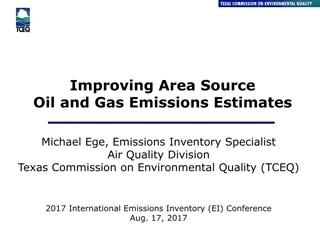Detailed Overview of Emissions Development in Louisiana
Emissions Processing System (EPS3) generates chemically speciated, gridded formats required by CAMx, with a focus on raw annual/ozone season county/parish-level emission inventory files and support data. Spatial and temporal profiles, along with cross-reference files, are essential for this work, covering various emission sources such as on-road, non-road, biogenics, and fires. The use of different emission modeling tools like MOVES, CONCEPT, NMIM, MEGAN, FINN, and Alpine Geophysics are crucial for detailed emission analysis. Criteria pollutants split to CB6 chemical mechanism and spatial allocation through gridding surrogates are also discussed.
Download Presentation

Please find below an Image/Link to download the presentation.
The content on the website is provided AS IS for your information and personal use only. It may not be sold, licensed, or shared on other websites without obtaining consent from the author.If you encounter any issues during the download, it is possible that the publisher has removed the file from their server.
You are allowed to download the files provided on this website for personal or commercial use, subject to the condition that they are used lawfully. All files are the property of their respective owners.
The content on the website is provided AS IS for your information and personal use only. It may not be sold, licensed, or shared on other websites without obtaining consent from the author.
E N D
Presentation Transcript
Development of Emissions for Louisiana, Gulf, Biogenics, Fires Chris Emery ENVIRON International Corporation, Novato CA November 14, 2012 Template Template
Summary Emissions Processing System, version 3 (EPS3) Generates hourly, chemically speciated, gridded formats needed by CAMx Needs raw annual/ozone season county/parish-level emission inventory files Needs support data Spatial surrogates, temporal and speciation profiles, cross- reference files Products for this work Hourly point, area, on/non-road mobile CB6 compounds 36/12/4 km grid system Sep-Oct 2010 representative weekday, Saturday, Sunday Day-specific for on-road, certain points, and fires 2
Summary Other emission modeling tools MOVES/CONCEPT for on-road (LA only) NMIM/NONROAD for non-road sources (LA only) MEGAN for biogenics (all grids) FINN for wildfires and agricultural burning (all grids) Anthropogenic emissions outside LA by Alpine Geophysics Emissions developed for 2010 Actual (for model performance evaluation) 2010 Typical (for projecting to future year) 2017 Typical (for developing RRFs) 3
CB6 Speciation and Temporal Allocation Criteria pollutants split to CB6 chemical mechanism Nitrogen oxides (NOx): NO, NO2, HONO Volatile organic compounds (VOC): ACET, ALD2, ALDX, BENZ, ETH, ETHA, ETHY, ETOH, FORM, IOLE, ISOP, KET, MEOH, OLE, PAR, PRPA,TERP, TOL, XYL Standard source-specific speciation profiles From EPA SPECIATE 4.3 database Profiles assigned to each source category We used default EPA cross-references Standard source-specific temporal profiles for most categories Default EPA season, month, day-of-week, hour profiles We used default EPA cross-references 4
Spatial Allocation Gridding surrogates on the 4 km modeling domain EPA Spatial Allocator tool http://www.cmascenter.org/index.cfm Typical surrogate types were created including: Population, various road types and other transportation networks, agriculture, residential, commercial and industrial land, retail, and water bodies Spatial Allocator creates surrogates formatted for the SMOKE emissions model Reformatted to EPS3 67 individual spatial surrogates gridded to the modeling domains using GIS overlays 5
Louisiana Point Sources LDEQ 2010 annual permitting database Temporally allocated to month, day of week, and hours Default EPA profiles & cross-references EPA ARP/CAMD 2010 hourly point SOx/NOx database ARP facilities matched to LDEQ database ARP NOx used to scale LDEQ VOC & CO to hourly LDEQ sources removed to avoid double-counting Speciated to CB6 Default EPA profiles & cross-references Located in grid according to stack coordinates 6
Louisiana Area Sources Stationary sources not identified as individual points Many types, distributed over a large spatial extent (i.e. parish) 2009 data obtained from LDEQ Assume 2009 emissions representative of 2010 no adjustment Speciated to CB6 Default EPA profiles & cross-references Temporally allocated to month, day of week, and hours Default EPA profiles & cross-references Spatially allocated to the CAMx grid system Source categories mapped to spatial surrogate codes Default EPA cross-references 7
Louisiana On-Road Mobile Emissions during operation and non-operation Does not include refueling (area source) Two models were used for Louisiana MOtor Vehicle Emission Simulator (MOVES); CONsolidated Community Emissions Processor Tool, Motor Vehicle (CONCEPT MV). 8
MOVES MOVES2010a (model) and movesdb20100830 (database) Run in Emission Rate Calculation mode by parish Outputs emission factor tables (g/mi or g/vehicle/hr) By process (start, running, evaporative) Run for range of conditions to produce lookup tables Range of meteorological conditions calculated from WRF using MET2MOVES tool Local data provided by LDEQ Age Distribution, Fuels and I/M programs, by parish 2011 annual average day VMT by road type and parish 2011 vehicle population by parish for four source types: Motorcycle Passenger Car Passenger Truck Light Commercial Truck 9
MOVES 3 parish groups identified for combinations of age distribution, fuel properties, and I/M programs East Baton Rouge Parish Jefferson Parish St. Tammany Parish I/M and RVP controls RVP controls only Neither I/M nor RVP controls Ascension Beauregard Acadia De Soto Natchitoches Tangipahoa East Baton Rouge Calcasieu Allen East Carroll Ouachita Tensas Iberville Grant Assumption East Feliciana Plaquemines Terrebonne Livingston Jefferson Avoyelles Evangeline Rapides Union West Baton Rouge Lafayette Bienville Franklin Red River Vermilion Lafourche Bossier Iberia Richland Vernon Orleans Caddo Jackson Sabine Washington Pointe Coupee Caldwell Jefferson Davis St. Helena Webster St. Bernard Cameron La Salle St. John the Baptist West Carroll St. Charles Catahoula Lincoln St. Landry West Feliciana St. James Claiborne Madison St. Martin Winn St. Mary Concordia Morehouse St. Tammany 10
CONCEPT MV Combines MOVES emission factors with VMT, vehicle population, and speed activity Gridded hourly meteorology from WRF Gridded activity and population using spatial surrogates according to road type or specific emissions type Surrogate assignments from EPA/SMOKE cross-references Daily average vehicle speeds by road type provided by Louisiana DOTD Temporal allocation of annual VMT by vehicle class from monthly, day-of-week, and hourly profiles Hourly fleet mix temporal profiles Weekday fleet mix from the previous Louisiana SIP Weekend fleet mix as daily average of weekday constant all hours Outputs gridded, hourly model-ready files 11
Louisiana On-Road Emissions, 8-9 AM, 9/1/10 NO (mol/hr) PAR (mol/hr) 13
Louisiana Non-Road Mobile EPA National Mobile Inventory Model (NMIM) NMIM20090504 and NONROAD2008a (models) with county database NCD20090531 Estimates emissions from the following equipment Agricultural equipment Airport ground support Construction equipment Industrial and commercial equipment Residential and commercial lawn and garden equipment Logging equipment Recreational equipment Recreational marine vessels 14
Louisiana Non-Road Mobile Parish-level gasoline fuel parameters from LDEQ Consistent with on-road inventory All non-gasoline equipment used default parameters EPS3 used to generate model-ready files Speciated to CB6 compounds Temporally allocated to day of week and hour of day Spatially allocated using EPA default categories and cross- references NMIM/NONROAD do not include railroad locomotives, aircraft, and marine vessels Locomotive and aircraft extracted from the 2008 NEI Processed as area sources Marine vessels developed separately 15
Haynesville Shale O&G Development Straddles border between Northeast TX and Northwest LA Focus of exploration and leasing activity Study by Northeast Texas Air Care (NETAC) Investigate Haynesville Shale activity projections on future ozone Annual production for 2009-2020 estimated for three scenarios Aggressive, moderate, and limited development Used to develop multiple future emission inventories 2012 emission projections vs. 2010 actual activity Limited (low) scenario matched 2010 well sources Aggressive (high) scenario matched 2010 drill rigs Spatial allocation based on LDNR Haynesville Shale wells data http://sonris- www.dnr.state.la.us/gis/agsweb/arcgisserver/arcgisoutput/extData/s hp/Haynesville_wells.zip 16
Louisiana Ports and Shipping Lanes ENVIRON project for LDEQ in 2010 Based on 2002 EPA estimates for Category 3 ocean- going vessels Projected to 2006 for past SIP modeling Emissions by port and transit mode in link-based format Five LA Ports Baton Rouge, Lake Charles, New Orleans, Port of Plaquemines, Port of South Louisiana Four transit modes Hoteling, maneuvering, reduced speed zone (RSZ), cruise mode (CM) 17
Louisiana Ports and Shipping Lanes Reformatted to EPS3 PRESHP module Hoteling/maneuvering modeled as points located at port RSZ modeled as line sources CM not used to avoid double counting Gulf-wide emissions 2006 estimates projected to 2010 Activity Annual total commodity tonnage summary http://www.ndc.iwr.usace.army.mil/data/datappor.htm Factor was estimated as 1.0035 NOx emission reductions 2020 EPA-estimated control factors for different engine/ship types 2006-2010 interpolation was 0.9781 Emissions assumed to be constant in time 18
Port Fourchon O&G support center Emission estimates may have been historically under estimated Updates from Starcrest Consulting Group, LLC and Louisiana State University (2010) We ignored off-shore estimates Processed separately with Gulf-wide emissions Data imported into EPS3 system Spatially allocated to two grid cells covering the port Processed as area sources CB6 speciation by source category, temporally constant 19
Gulf-Wide Sources Commercial marine shipping and O&G platform emissions Acquired by sub-contractor ERG Latest 2008 estimates from BOEM (formerly MMS) 2008 O&G projected to 2010 Using 2008 and 2010 production by BOEM Lease Numbers Assumed 2008 non-oil-related data were representative of 2010 (no projection) Processed in EPS3 as combination of point and area sources CB6 speciation using default EPA cross references Point coordinates, lease tracts, shipping lanes for spatial allocation 21
Biogenic Emissions MEGAN version 2.10 Calculations driven by vegetative cover, weather Global land cover data at 1 km resolution LAI from 2008 MODIS data, 1 km/8-day resolution Plant Functional Type fractional (PFTf) coverage from 30-meter 2008 LANDSAT TM data Updated emission factors, improved US species composition data Gridded meteorological data from WRF Temperature, solar radiation, wind speed Photosynthetically Active Radiation (PAR) Solar radiation from WRF (this project) No missing data, but subject to model error (cloud cover) Product is gridded, hourly, CB6 model-ready files Biogenic emissions for each hour, each day, 36/12/4 km grids 22
Wild/Agricultural Fires Fire Inventory from NCAR (FINN) version 1 http://bai.acd.ucar.edu/Data/fire/ Global dataset of daily emissions from satellite (1 km) Species: NOx, PM2.5, CO, and VOC Speciated to MOZART-4 6 fire types Tropical, temperate, and boreal forests, cropland, shrublands, and grasslands Data were windowed to the 36/12/4 km modeling grids Fire points within 5 km of each other were combined into a single complex Ingested into EPS3 fire module Mapped to CAMx CB6 speciation Uses WRAP methodology to temporally and vertically (by altitude) distribute daily emissions 23























